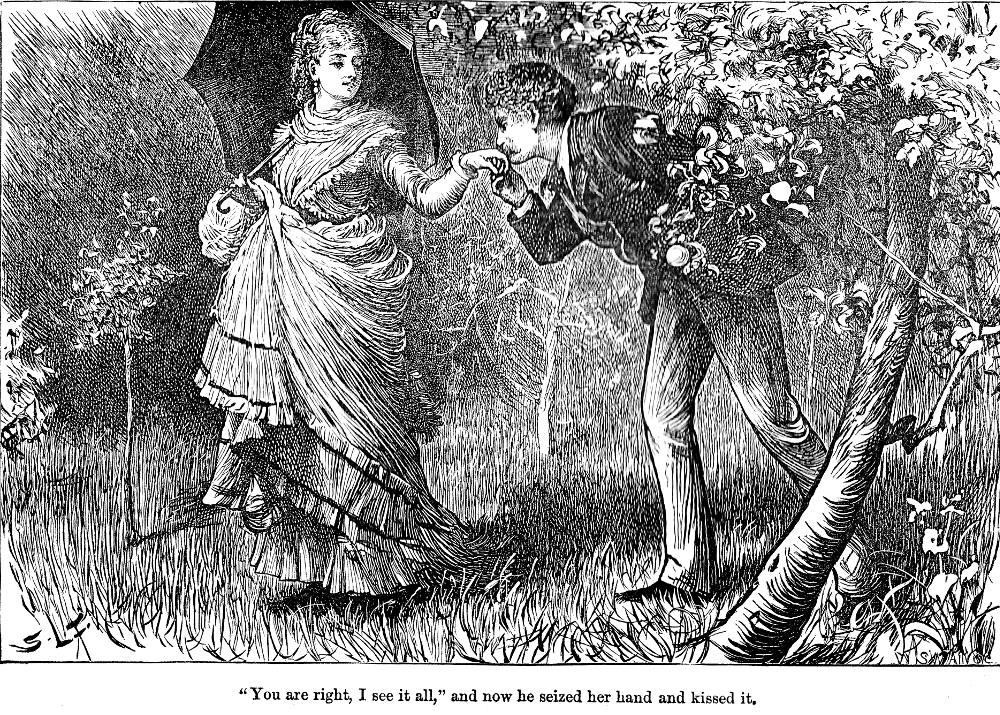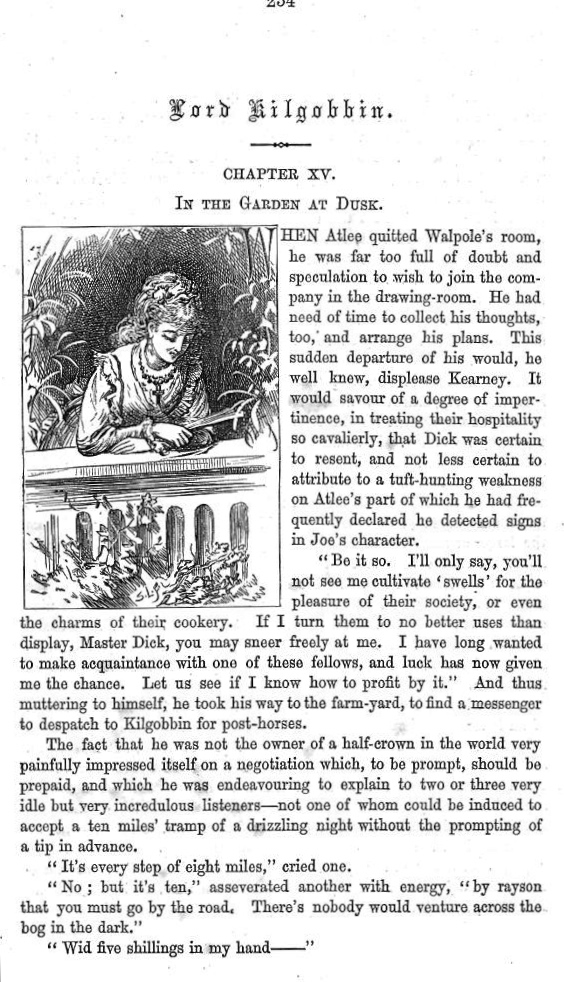
"You are right, I see it all," and now he seized her hand and kissed it by Sir Luke Fildes; engraver, Swain. Sixth illustration for Charles Lever's Lord Kilgobbin: A Tale of Ireland in Our Time, facing page 99. Reprinted from the March 1871 number of the Cornhill Magazine. 10.5 cm by 16 cm (4 by 6 ¼ inches), framed. Part 5, Chapter XV, "In the Garden at Dusk," facing p. 234. [Click on the illustration to enlarge it.]
Passage Illustrated

Right: The initial page for the fifth instalment in Volume XXIII of the Cornhill Magazine (February, 1871).
"That is, you see, in fact, that Mr. Walpole could never have presumed to give you such instructions — that gentlemen do not send such messages to young ladies — do not presume to say that they dare do so; and last of all, if they ever should chance upon one whose nice tact and cleverness would have fitted him to be the bearer of such a commission, those same qualities of tact and cleverness would have saved him from undertaking it. That is what you see, Mr. Atlee, is it not?"
"You are right. I see it all." And now he seized her hand and kissed it as though he had won the right to that rapturous enjoyment.
She drew her hand away, but so slowly and so gently as to convey nothing of rebuke or displeasure. "And so you are going away?" said she softly. [Chapter XV, "In the Garden at Dusk," 99]
Commentary: Nina's Flirtatiousness
In the scene between Nina and Joe Atlee in the garden of Kilgobbin Castle, Fildes emphasizes Joe's assumed gallantry and Nina's flirtatiousness. She demurely holds up her skirts as it is raining, despite the fact that she has taken the precaution of picking up an umbrella after agreeing to meet Dick Kearney's college roommate outside, where Joe can convey the wounded Cecil Walpole's message in confidence. Still suffering acutely from a gunshot wound to the arm sustained on the night of the Fenian assault, Cecil has asked Joe, something of an amateur physician, to accompany him back to Dublin Castle. As the Viceroy, Lord Danesbury's Private Secretary, Cecil is in a good position to address misconceptions about the attack in Kilgobbin Castle that the popular press of both Orange (Protestant) and Green (Nationalist) complexions has been purveying recently. Cecil has asked Joe to let Nina know that they will be leaving shortly in a hired carriage. Through a few representative shrubs and a fruit tree Fildes has realised the following description of the garden setting: "It was a large, ill-cultivated space, more orchard than garden, with patches of smooth turf, through which daffodils and lilies were scattered, and little clusters of carnations occasionally showed, where flower-beds had once existed" (97). Although he has depicted the figures accurately, with Nina's fetching ankle and instep revealed by the gathering up of her skirt, and Joe's chivalrously kissing her hand, Fildes has not depicted the daffodils, lilies, and carnations that Lever thinks the chief beauty of the garden.
Scanned images, captions, and commentary by Philip V. Allingham. [You may use these images without prior permission for any scholarly or educational purpose, as long as you (1) credit the person who scanned them, and (2) link your document to this URL in a web document or cite the Victorian Web in a print one.]
Bibliography
Lever, Charles. Lord Kilgobbin. The Cornhill Magazine. With 18 full-page illustrations and 18 initial-letter vignettes by S. Luke Fildes. Volumes XXII-XXV. October 1870-March 1872.
Lever, Charles. Lord Kilgobbin: A Tale of Ireland in Our Own Time. With 18 Illustrations by Sir Luke Fildes, R. A. London: Smith, Elder, 1872, 3 vols; rpt., Chapman and Hall, 1873.
Lever, Charles. Lord Kilgobbin. Illustrated by Sir Luke Fildes. Novels and Romances of Charles Lever. Vols. I-III. In three volumes. London: Smith, Elder, 1872, Rpt. London: Chapman & Hall, 1873. Project Gutenberg. Last Updated: 19 August 2010.
Stevenson, Lionel. Chapter XVI, "Exile on the Adriatic, 1867-1872." Dr. Quicksilver: The Life of Charles Lever. New York: Russell and Russell, 1939; rpt. 1969. Pp. 277-296.
Sutherland, John A. "Lord Kilgobbin." The Stanford Companion to Victorian Fiction. Stanford, Cal.: Stanford U. P., 1989, rpt. 1990, 382.
Created 24 October 2007 Updated 19 June 2023